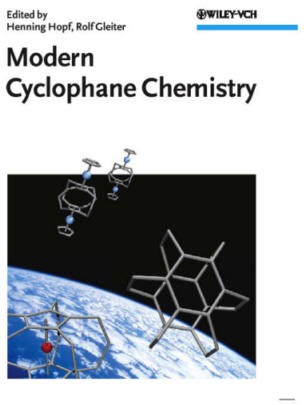The present book, "Modern Cyclophane Chemistry", edited by Prof. Gleiter and Prof. Hopf is best classified as an extensive monograph consisting of 20 chapters written by a group of authors that reads like the "who is who"
in cyclophane chemistry. The greater area is organic and organometallic chemistry. The book is clearly written for the academic researcher/professor and graduate students in the field of organic chemistry. On 543 pages it contains everything the reader always wanted to know but never dared to ask about cyclophane chemistry.The book fits well into the vastly popular "modern" series of VCH: Modern Acetylene Chemistry I and II, Modern Arene Chemistry, Modern Allene Chemistry etc. and has the same aspiration to quality and comprehensiveness. Overall a superb book edited by two giants in the field of cyclophane chemistry.
The reviewer has read a couple of the 20 chapters and has browsed through the rest of them. The first impression is that of a very carefully edited and esthetically pleasing opus. The chapters I read carefully were Prof. Tobe's chapter 1 (Cyclophynes), Tsuji's chapter 3 (Highly strained cyclophanes), chapter 4 by Prof. Gleiter and Dr. Rolf Roers, as well as chapters 13 (Fully conjugated beltenes) by Prof. Herges and chapter 20 by Prof. Diederich (Molecular recognition studies with cyclophane receptors).
All of the chapters that the reviewer has read were well structured, pedagogically valuable, easily readable and gave excellent references to published material including that to the contributions of the authors and to that of other groups. The use of graphics, figures and pictures was very appropriate and helps in the easy understanding of the topics that are discussed. The same is true for the chapters the reviewer did not read through carefully but rather browsed through. A significant amount of information could be gleaned from the beautiful, carefully done and high quality graphics.
The topics in the chapters the reviewer read were all quite comprehensively treated, which is a sign of real quality of the book under consideration. This monograph gives an excellent historical overview as well as a timely review of the ever growing and fascinating field of cyclophane chemistry. A particularly attractive feature for academic personnel are the exciting structures and reactions and their easy use for topics in a graduate classes. The book brings sophisticated yet important examples of organic reactions that are valuable for the construction of non-natural products
and it should not be missing in the reference library of the Professor of Organic Chemistry or of Organic Materials/Polymer Science.The subject index is easy to use and gives excellent reference to the topics treated in this volume. Particularly advantageous is that the UV-vis spectra (Prof. Rademacher, Chapter 11, UV-vis spectra of cyclophanes) are tabulated and easily accessible almost like in a reference book. These tables will help the active scientist who is interested to
enter the cyclophane area to determine how to design a cyclophane for a specific use.Overall it was a pleasant experience to read and review this excellent, exciting yet rounded monograph about cyclophane chemistry that should be bought by interested graduate students and Professors. The book should be
in every library. Both the editors, as well the authors of the single chapters did an excellent job in the creation of this opus.
Prof. Dr. Uwe H. F. Bunz
School of Chemistry and Biochemistry
Georgia Institute of Technology, Atlanta, GA 30332
